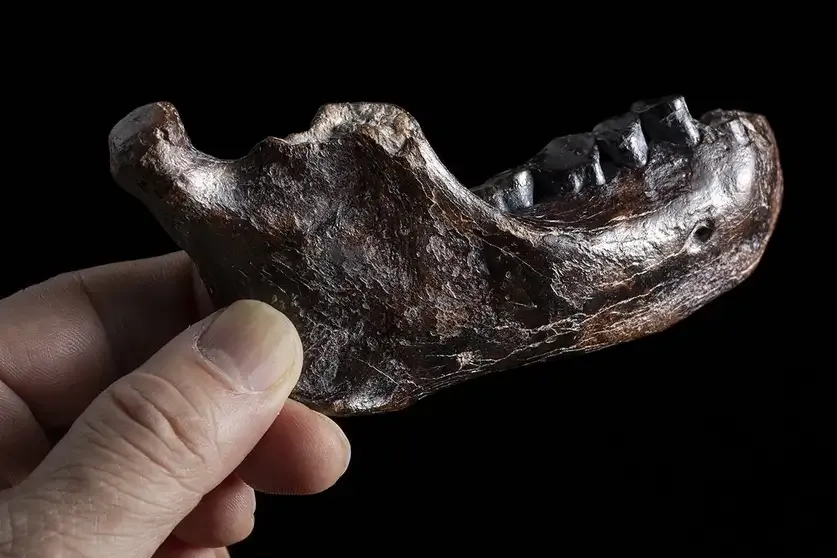Mysterious Jawbone Found at an Antique Shop in Taiwan Belonged to a Male Denisovan, Scientists Say
Mysterious Jawbone Found at an Antique Shop in Taiwan Belonged to a Male Denisovan, Scientists Say
The fossil, called Penghu 1, is one of the few known pieces of physical evidence from the Denisovans, extinct relatives of modern humans. It suggests the species lived in diverse environments
Researchers extracted ancient proteins from the bone and tooth enamel.
Chun-Hsiang Chang, Jay Chang
Fossil collector Kun-Yu Tsai was perusing antiques in 2008 when an unusual-looking jawbone caught his eye. Intrigued by the object, he purchased it and ultimately donated it to the National Museum of Natural Science in Taiwan.
For years, the fossilized jawbone has perplexed researchers. It’s similar to the mandibles of modern humans, but it’s thicker and has bigger teeth—it’s also missing the prominent chin that humans have today. As a result, scientists suspected it belonged to a human ancestor, but they didn’t know which one—until now.
The jawbone belonged to a Denisovan, an extinct hominin species first described in 2010, scientists report this week in the journal Science. The discovery suggests Denisovans were adaptable to a variety of environments and climates, from chilly, high-elevation places like Siberia and the Tibetan Plateau to warm, humid locales like Taiwan.
Scientists have been trying to solve the mystery of the lower jawbone, known as Penghu 1, for more than a decade. Before ending up at the antique shop in southern Taiwan, it had been dredged up from the Penghu Channel by commercial fishermen. Over time, the bone had taken on a muddy, dark brown hue, while the five still-attached teeth had turned black.
At first, researchers tried to extract DNA from the mandible. But because of Taiwan’s warm, muggy climate, which degrades ancient DNA, these attempts were unsuccessful.
Undeterred, they decided to try another method: investigating ancient proteins embedded in the fossil’s bone and tooth enamel. Proteins often outlast DNA in fossils, and they can serve as unique signatures for a species.
The jawbone belonged to a male Denisovan, an extinct relative of modern humans.
Cheng-Han Sun
This “paleoproteomic” technique worked. Researchers discovered two protein variants found only in other Denisovan fossils—a smoking gun for identifying which species Penghu 1 had come from.
“[The variants] don’t exist in the Neanderthals,” says Bastien Llamas, a geneticist at the University of Adelaide in Australia who was not involved with the research, to the Australian Broadcasting Corporation’s Anna Salleh. “They don’t exist in humans. They’ve only been detected so far in Denisovans.”
They found another protein that’s coded for on the Y chromosome, which revealed the jawbone belonged to a male.
Researchers still don’t know when the Denisovan lived, however. They’ve tried numerous ways to come up with a date range for the fossil, including radiocarbon and uranium-series dating. But because of the bone’s condition, they have only been able to narrow down the timeline to two wide potential periods: either between 10,000 to 70,000 years ago or 130,000 to 190,000 years ago. These time frames are associated with lower sea levels, which would have put the fossil discovery site above water, according to Science’s Michael Price.
Now that the jawbone has been confirmed as belonging to a Denisovan, it joins the very small ranks of known Denisovan fossils. Only a handful of bones and teeth have been unearthed since scientists first identified the species 15 years ago, so “every piece that is informative changes our picture” of the Denisovans, says study co-author Frido Welker, a molecular anthropologist at the University of Copenhagen, to Scientific American’s Cody Cottier.
Meanwhile, scientists are still piecing together how Denisovans fit into the human family tree. Their DNA has been found in modern humans, which points to interbreeding between Denisovans and Homo sapiens.
But when and where did the two species overlap? The lack of Denisovan fossils makes these questions even harder to answer, but findings like Penghu 1 “help expand our understanding of where those interactions might have taken place,” says Kelsey Witt, a geneticist at Clemson University who was not involved with the research, to Science.
Get the latest stories in your inbox every weekday.


